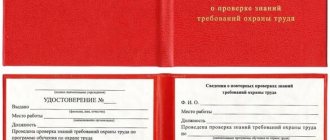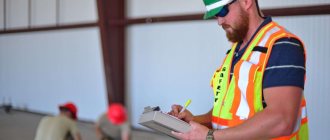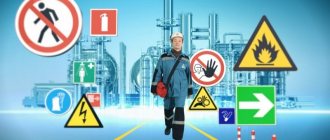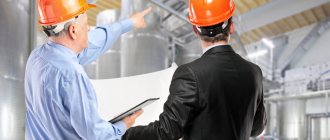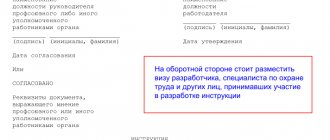What is three-stage labor protection control and why is it required?
The key objective of occupational safety control is the safety of workers while maintaining production efficiency. It is important to ensure that all employees understand the rules. Objectives of the enterprise security system:
- carrying out a number of changes in the labor safety of workers;
- identifying problematic work issues and unsafe situations;
- selection of responsible persons monitoring workplace safety;
- finding and eliminating flaws.
Three-stage labor protection control
How is three-stage control carried out?
The organization of three-stage control is usually carried out by the head of the company, the labor protection service and the head of the trade union or other representative body of workers. Control is carried out:
- at the first stage - at the unit site, in a shift or brigade;
- at the second stage - in the department as a whole;
- at the third stage - in the organization as a whole.
The results of three-stage control are reflected in the Journal of Three-Stage Monitoring of Labor Conditions and Safety (hereinafter referred to as the Journal of Three-Stage Control).
First stage of control
Control at the first stage is carried out daily before the start of work by site managers (foremen, site managers, shift supervisors) together with a member of the trade union authorized for labor protection. At this stage you need to check:
- whether violations identified during the previous inspection have been eliminated;
- the state of working conditions at each workplace;
- condition of passages and driveways;
- the presence of protective and signal fences;
- availability of proper tools and equipment necessary for the work;
- safety of technological equipment, lifting and transport vehicles;
- compliance with the rules for storing materials, workpieces, devices;
- availability, serviceability and correct use of personal protective equipment by employees;
- the state of electrical safety and compliance by employees with electrical safety rules when working on electrical installations and with power tools;
- workers have certificates, work permits, and other documents for performing work with increased danger.
Identified violations must be corrected immediately. This process is controlled by the immediate supervisor of work at this site. If the violations cannot be eliminated by the site, then the immediate supervisor of the work, upon completion of the inspection, reports this to a superior supervisor. Together they will decide what measures need to be taken to eliminate errors and appoint employees responsible for their implementation.
The employee who conducted the inspection or the site manager makes a record of the identified violations in the Three-Stage Control Log. The entry must be signed by the labor safety representative of the trade union or other representative body of workers.
If, at the first stage of control, a gross violation of labor protection is detected, which can harm the health of employees or lead to an accident, then work is suspended until the violation is eliminated. At the same time, in the three-stage control log, the inspectors make a note that it is recommended to suspend work until the violations are eliminated.
The work manager must inform his subordinates about all detected inconsistencies. In addition, he reports daily on the state of labor protection at his site to his superior manager.
Second stage of control
The head of a workshop, department, or construction site is appointed responsible for control at the second stage with the participation of a labor protection representative from the trade union. At this stage, representatives of the technical services of the unit (for example, the service of the chief mechanic, chief power engineer, chief technologist), and a specialist from the organization’s labor protection service can join the inspection.
It is recommended to carry out monitoring at least twice a month, and check:
- organization, frequency and results of the first stage of control;
- maintaining a three-stage control log;
- implementation of activities planned after previous inspections at the first and second stages of control;
- implementation of orders of the head of the organization and the trade union on labor protection issues;
- compliance with the instructions of state supervision and control bodies;
- implementation of measures developed based on the results of accident investigations;
- serviceability and compliance of production equipment, vehicles and technological processes with the requirements of regulatory legal acts on labor protection;
- compliance with schedules of preventive maintenance of mechanisms, equipment, and technological operating modes;
- the state of labor protection in departments, the presence of labor protection posters, signal colors, safety signs;
- availability and serviceability of protective, signaling and fire-fighting equipment and devices, instrumentation;
- timeliness and quality of training of workers on labor protection;
- availability and correct use of personal protective equipment by employees;
- condition of sanitary facilities and facilities;
- compliance with the established work and rest regime, labor discipline.
Violations that cannot be eliminated on the spot are recorded in the Three-Stage Control Log in the form of comments. The head of a structural unit must organize measures to eliminate violations and once a month report to the labor protection committee on the state of labor conditions and safety in his structural unit.
Third stage of control
Control at the third stage is carried out by a commission headed by the head of the organization or the chief engineer and the chairman of the trade union committee. It also includes the head of the labor protection service, technical service and an authorized labor protection officer from the trade union.
Control is carried out at least once a quarter (usually once a month), and the following is checked:
- organization, frequency and results of the first and second stages of control;
- maintaining a three-stage control log;
- implementation of activities provided for by collective agreements, labor protection agreements and other documents;
- implementation of measures developed based on the results of the investigation of severe and group accidents and accidents;
- technical condition and maintenance of buildings, structures, premises, workshops and adjacent areas;
- implementation of orders and instructions, instructions and instructions of state supervisory authorities;
- provision of workers with sanitary facilities and devices;
- organization of training and briefings on labor protection.
Based on the results of the inspection, the commission draws up a report, and the identified violations are recorded in the Three-Stage Control Log of the unit in which the inspection was carried out.
In addition, the head of the organization reviews the results of the third stage of control with the participation of heads of structural divisions, chief specialists, and representatives of the trade union organization. Together they develop measures that can be used to eliminate identified shortcomings and violations, and the head of the enterprise appoints performers and deadlines for completing these measures. Based on the results of the meeting, a protocol is drawn up.
After this, if necessary, the manager issues an order to bring to disciplinary liability workers who have committed violations of labor protection or are guilty of unsatisfactory organization of work in this area. And vice versa: employees who have achieved positive results in their work on occupational safety and health can be rewarded.
Three-stage control over labor protection, normative document
1st stage of control
Occupational Safety Month: order for implementation
The head of a structural unit of the organization organizes the work of a team or shift to implement occupational safety tasks. It checks the following indicators daily:
- violations found during an earlier inspection;
- passable passages in premises, crossings, adjacent roads, the possibility of prompt evacuation;
- degree of danger of the equipment used;
- quality of ventilation equipment;
- list of working tools, materials, their compliance with requirements;
- literacy of the instructions.
Photo development of three-stage control
Important! In special cases, the use of protective clothing during work is mandatory. Some professions require permission to work and special certificates. If employees work with flammable elements, special attention must be paid to fire safety.
2nd stage of control
The initial stage involves the implementation of general measures and the search for obvious shortcomings. The next level of control is organized directly by the head of the department, branch or base. It performs the following actions:
- checking the premises where employees work and the conditions there;
- keeping records in a special OT journal;
- ways to eliminate deficiencies identified at the first stage;
- ventilation and lighting conditions; protective equipment;
- employee training;
- creation of an algorithm for eliminating deficiencies.
Composition of control measures
The specific composition of activities is determined by the specifics of the type of activity. For clarity, let us consider three-stage control in the printing industry.
1st. A master with a safety representative controls:
- workplaces and approaches to them;
- ventilation, lighting;
- equipment, tools, devices, their condition;
- alarms, blockers, braking devices;
- electrical safety;
- availability of special clothing, safety shoes, and protective equipment for each employee;
- check the entries in the equipment technical control log, compare them with the actual condition, record the inspection and its results in the 3-stage control log;
- eliminate deficiencies if they are found.
2nd. The shop manager and the safety representative check:
- premises, workplaces therein and working conditions;
- how the deficiencies discovered at the first stage of the audit were eliminated;
- similar: lighting, room ventilation, equipment, protective equipment;
- selectively: employee knowledge of occupational safety standards and rules;
- make an entry in the 3-stage control log;
- develop ways to eliminate shortcomings if they are identified.
3rd. The chief engineer and the safety commission headed by him monitor:
- condition of premises and workplaces;
- condition of equipment involved in production;
- operation and condition of protective equipment, safety equipment, including individual ones;
- the process and result of eliminating deficiencies identified at previous stages of control;
- implementation of decisions, orders of management and the trade union committee on occupational safety.
The results of the commission’s work are entered into the 3-stage control log and discussed at a meeting of its members. Ways to improve safety in the field of occupational safety are outlined. The commission draws up and signs a corresponding document, which reflects all the work it has done.
Members of the commission, in addition to the chief engineer himself, may be other chief specialists: a power engineer, a technologist, a mechanic, a representative of the trade union committee who heads its commission on occupational safety; OT engineer. The commission also includes representatives of the fire and medical services of the enterprise (according to the text of Order No. 237).
According to a similar principle, taking into account the type of activity, control is carried out in other production areas.
The third level of labor protection control
KSOT-P for labor protection of Russian Railways and at the production facility
The two-stage system is considered insufficiently productive. Therefore, the chief engineer gets involved in the work and convenes a special commission. A proposal is prepared for the employer to improve working conditions, and the commissioner proposes a plan for their improvement. The technical specialist has the right to cancel a rule that does not comply with the norm. Technical specialists carrying out three-level control over labor safety:
- check work premises, offices, sanitary areas, workshops, places for work and rest;
- testing equipment used in production;
- observe the progress of the work process;
- keep records of protective equipment, incl. individual;
- ensure the elimination of previously identified deficiencies:
- implement the instructions of management and trade union organizations.
Second stage
The second stage of control is carried out by the head of the workshop (section) according to the established schedule together with a representative of the workforce.
This stage involves checking:
- correct control of the first stage;
- elimination of violations identified by the first stage of control, as well as by previous inspections;
- timely execution of orders, instructions, and other regulations regarding labor safety issues;
- the state of protection of workplaces from the influence of harmful production factors;
- correctness of the technological process;
- sanitary condition of domestic and industrial premises;
- compliance with equipment maintenance schedules;
- design of occupational safety corners, visual propaganda stands;
- the correctness of issuing work orders for the execution of work, carrying out all types of labor safety briefings within the established time limits;
- availability and correct installation of safety warning signs at workplaces;
- uninterrupted provision of therapeutic and preventive nutrition to employees and other established means of preventing occupational diseases;
- compliance with the work and rest regime of workers.
The results of the inspections are recorded by the person conducting the inspection in a journal of the established form.
Rights and obligations of authorized persons
The 2006 resolution of the FNPR Executive Committee describes the general rights and responsibilities for labor safety in Russia. The person responsible for occupational safety, who was selected by the enterprise management, is obliged to help maintain optimal working conditions at the site that meet generally accepted standards, rules and instructions.
Occupational safety through three-stage control
Responsible persons are obliged to monitor the condition of workplaces:
- check the condition of the premises in which people work;
- investigate accidents;
- make proposals to improve working conditions;
- receive assignments from management in the field of activity;
- be members of the verification commission;
- protect the rights of Trade Union participants;
- demand cessation of work under conditions hazardous to health;
- hold employees who violate the rules accountable.
What is needed to implement three-stage control
The normal functioning of three-level security requires the creation of a workers' union. The chairman of the work organization forms and implements public control, requiring colleagues to adhere to safety regulations. In addition, he forms a committee that develops and implements relevant instructions and regulations.
Magazine
Sample magazine design
Normative base
List of the most important legislative acts that the company must comply with:
- Section 10 of the Labor Code;
- Federal Law 125, On Compulsory Social Insurance;
- Federal Law 123, which is essentially a technical regulation for creating safe working conditions;
- various industry rules on labor protection, orders of the Ministry of Health and Social Development;
- professional standards.
In conclusion, we can say that three-stage labor protection control is an effective way to create modern and safe conditions in the company. To introduce such a concept at an enterprise, you will need to involve several specialists, creating a multi-level control system.
Levels
As stated above, GOST R. 12.0.007-2009 defines the activities that are included in the three-stage labor protection control. The regulatory document, in particular, provides for the following levels of monitoring:
- The foreman and the trusted (authorized) labor union safety officer inspect all workplaces every day. Identified problems must be corrected immediately.
- The head of the site (shop) and an authorized employee with an occupational safety engineer perform a walk-through once a week. The results of inspections are recorded in occupational safety journals. They indicate the performers and the deadline for eliminating the identified inconsistencies.
- The institution's committee (commission) studies the state of occupational safety in the department once a month. Based on the results of the inspection, a report on violations is drawn up and an order is issued to eliminate them.
Supervision and control of labor protection in companies with a small number of employees is carried out in two stages:
- The manager inspects all workplaces daily.
- Every month, an in-depth examination is carried out by the occupational safety commission with the participation of leading employees of the company, an authorized representative of the trade union or the team.
Based on the results of the inspection, the noted deficiencies are recorded in occupational safety journals. They also record proposals for eliminating inconsistencies, deadlines for completing the relevant activities and performers. The latter sign.

